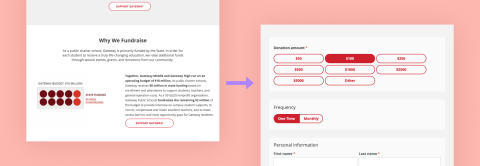
How To Apply Agile Marketing to Your Organization
Share
Agile marketing methodology is a suitable solution for all organizations, from established corporations to small nonprofits. Changes across the digital landscape are inevitable on the internet, and agile marketing equips organizations to respond swiftly. Agile marketing allows for quick adaptation to market changes.
Adopting an agile approach to your organization’s website does not happen overnight. It is a process that takes ongoing dialogue and deliberative action. To get a better idea of what agile marketing is and how this concept can be put into practice, we will first explore the early foundations of agile thinking.
The Foundations of Agile
The concept of agile marketing was initially founded upon ideas created by seventeen developers in the middle of Utah at a ski resort, titled the Manifesto for Agile Software Development. The fundamental principles they decided upon were:
Individuals and interactions over processes and tools
Working software over comprehensive documentation
Customer collaboration over contract negotiation
Responding to change over following a plan
The concept of agile thinking has since been applied worldwide and put into practice in tech-based workplaces. The leap from agile to agile marketing is a simple one; using core concepts from agile, such as collaboration and consistent iteration on projects, lends well to the digital marketing landscape. While agile marketing is best known for its ability to embrace change, there is a broader, more inspired methodology at play.
Applying Agile Marketing to Your Organization
As an organization, agile marketing assists in handling change. Often enough, organizations are continuously taking in new information and cannot necessarily adapt to the move because of the common bureaucratic hierarchy and not centered on the user’s needs.
There can be difficulty adapting communications and programs quickly enough to resonate synchronously with the rapidly changing digital landscape. An agile marketing approach is rooted in the concept that change is constant, especially on the internet. To get a better idea of what agile marketing is all about, let’s explore the four main principles of agile marketing.
There are four main principles to agile marketing:
- User-centered approach
- Collaborative thinking
- Action-oriented
- Working iteratively
User-centered approach
Users are the most crucial aspect of web design, so we structure our work around the user.
As a [role], I want to [task],
so that I can [goal or benefit].
These user stories assist in quick and light documentation to assist user goals.
Agile marketing is user-centered, meaning that the users are prioritized. This approach lends itself well to being adaptable and can approach change with ease and, subsequently, enthusiasm. An agile methodology is not process-driven and bureaucratic; it is iterative.
Collaborative thinking
Agile marketing means we don’t work in silos; we work collaboratively at every stage of the process. Working collaboratively actually increases productivity. According to the McKinsey Global Institute, frequent communication amongst an internal workforce can increase productivity by 25 percent.
We find projects that are collaborative end up having better results. At Kalamuna, we work seamlessly with project managers, content specialists, developers, designers at every aspect of a marketing campaign. We don’t talk to designers when we need a social card made; we ideate together from start to finish. This process helps with creating innovative, actionable campaigns.
Action-oriented
Applying agile marketing means it’s better to have a working project and idea in motion than to be bogged down by perfection. Emphasize an outcomes-driven approach with your teams. When you first learn how to write as a child, you don’t get every letter of the alphabet correctly when spelling your name. Maybe your ‘s’ is backward; perhaps you forgot a vowel; you shouldn’t expect perfection at your first go at creating your website. It’s okay if you don’t get it the first time; being action-oriented regarding agile marketing means focusing on creating outputs that you can learn from: if you fail, try, try again.
Working iteratively
As we build, we learn how to model and develop our digital presence. We have an opportunity to see what works for our users and see how our site performs directly. We learn, then two weeks later, we release a fix, users are going to respond.

We applied this iterative thinking when we collaborated with Virtual High School (VHS) to iteratively redesign key pages of their site to launch their rebrand rather than waiting for an entire rebuild. Remember, if it doesn’t work at first, that’s okay; we do it again until we create something that works. Embracing failure is a necessity when it comes to building a strong digital foundation.
The Importance of Building a Strong Digital Foundation
Redesigning a website takes time. There’s a strong argument to make an immediate investment in your digital presence. Being action-orientated towards your site, such as VHS, was updating critical pages on their site, is helpful for two reasons. For one, making an immediate investment in your organization’s site can mean saving thousands of dollars in opportunity cost down the line.

Working iteratively means creating smaller goals in bite-sized pieces. For instance, we assisted Gateway Public Schools in bringing a donation form on their site to reduce friction in their donor journey.
Successful websites are not made overnight. Change is constant, and sometimes adaptations occur more often in the post-launch period than in the build phase. And, in some cases, the more significant impact occurs without a complete redesign at all. Creating smaller goals can serve you in the long run rather than a make-it-or-break-it mindset. Expect your website will change and plan appropriately.
Conclusion
No organization is too small or too large to adopt an agile marketing methodology.
Redesigning your website is typically a costly and time-consuming process. However, using an agile methodology can establish the appropriate foundations for your organization to prepare for inevitable change occurring in the digital sphere.
Can’t get enough of agile marketing? Our partner, Pantheon, has created an informative guide to agile marketing if you’re interested in learning more.








